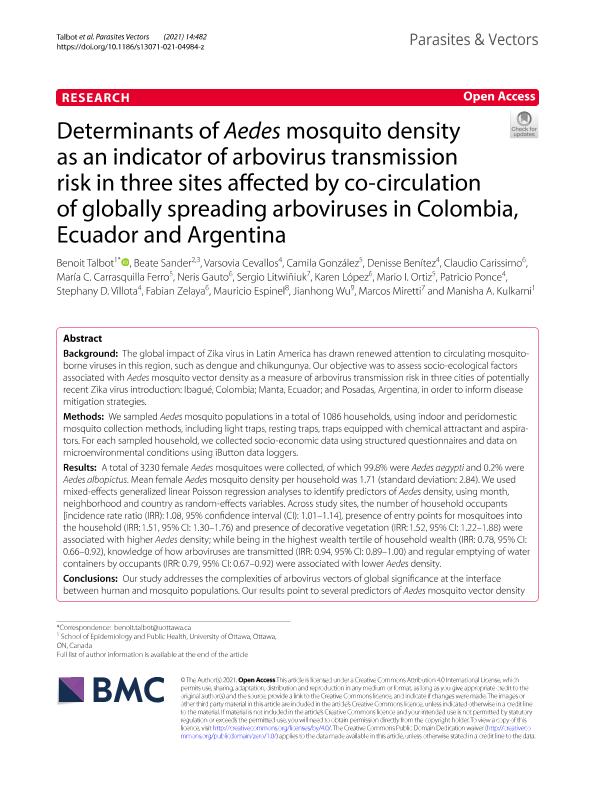Artículo
Determinants of Aedes mosquito density as an indicator of arbovirus transmission risk in three sites affected by co-circulation of globally spreading arboviruses in Colombia, Ecuador and Argentina
Talbot, Benoit; Sander, Beate; Cevallos, Varsovia; González, Camila; Benítez, Denisse; Carissimo, Claudio; Carrasquilla Ferro, María C.; Gauto, Neris; Litwiñiuk, Sergio Leandro ; López, Karen; Ortiz, Mario I.; Ponce, Patricio; Villota, Stephany D.; Zelaya, Fabian; Espinel, Mauricio; Wu, Jianhong; Miretti, Marcos Mateo
; López, Karen; Ortiz, Mario I.; Ponce, Patricio; Villota, Stephany D.; Zelaya, Fabian; Espinel, Mauricio; Wu, Jianhong; Miretti, Marcos Mateo ; Kulkarni, Manisha A.
; Kulkarni, Manisha A.
 ; López, Karen; Ortiz, Mario I.; Ponce, Patricio; Villota, Stephany D.; Zelaya, Fabian; Espinel, Mauricio; Wu, Jianhong; Miretti, Marcos Mateo
; López, Karen; Ortiz, Mario I.; Ponce, Patricio; Villota, Stephany D.; Zelaya, Fabian; Espinel, Mauricio; Wu, Jianhong; Miretti, Marcos Mateo ; Kulkarni, Manisha A.
; Kulkarni, Manisha A.
Fecha de publicación:
09/2021
Editorial:
BioMed Central
Revista:
Parasites and Vectors
ISSN:
1756-3305
Idioma:
Inglés
Tipo de recurso:
Artículo publicado
Clasificación temática:
Resumen
Background: The global impact of Zika virus in Latin America has drawn renewed attention to circulating mosquito-borne viruses in this region, such as dengue and chikungunya. Our objective was to assess socio-ecological factors associated with Aedes mosquito vector density as a measure of arbovirus transmission risk in three cities of potentially recent Zika virus introduction: Ibagué, Colombia; Manta, Ecuador; and Posadas, Argentina, in order to inform disease mitigation strategies. Methods: We sampled Aedes mosquito populations in a total of 1086 households, using indoor and peridomestic mosquito collection methods, including light traps, resting traps, traps equipped with chemical attractant and aspirators. For each sampled household, we collected socio-economic data using structured questionnaires and data on microenvironmental conditions using iButton data loggers. Results: A total of 3230 female Aedes mosquitoes were collected, of which 99.8% were Aedes aegypti and 0.2% were Aedes albopictus. Mean female Aedes mosquito density per household was 1.71 (standard deviation: 2.84). We used mixed-effects generalized linear Poisson regression analyses to identify predictors of Aedes density, using month, neighborhood and country as random-effects variables. Across study sites, the number of household occupants [incidence rate ratio (IRR): 1.08, 95% confidence interval (CI): 1.01–1.14], presence of entry points for mosquitoes into the household (IRR: 1.51, 95% CI: 1.30–1.76) and presence of decorative vegetation (IRR: 1.52, 95% CI: 1.22–1.88) were associated with higher Aedes density; while being in the highest wealth tertile of household wealth (IRR: 0.78, 95% CI: 0.66–0.92), knowledge of how arboviruses are transmitted (IRR: 0.94, 95% CI: 0.89–1.00) and regular emptying of water containers by occupants (IRR: 0.79, 95% CI: 0.67–0.92) were associated with lower Aedes density. Conclusions: Our study addresses the complexities of arbovirus vectors of global significance at the interface between human and mosquito populations. Our results point to several predictors of Aedes mosquito vector density in countries with co-circulation of multiple Aedes-borne viruses, and point to modifiable risk factors that may be useful for disease prevention and control.
Archivos asociados
Licencia
Identificadores
Colecciones
Articulos(IBS)
Articulos de INSTITUTO DE BIOLOGIA SUBTROPICAL
Articulos de INSTITUTO DE BIOLOGIA SUBTROPICAL
Citación
Talbot, Benoit; Sander, Beate; Cevallos, Varsovia; González, Camila; Benítez, Denisse; et al.; Determinants of Aedes mosquito density as an indicator of arbovirus transmission risk in three sites affected by co-circulation of globally spreading arboviruses in Colombia, Ecuador and Argentina; BioMed Central; Parasites and Vectors; 14; 1; 9-2021; 1-14
Compartir
Altmétricas



